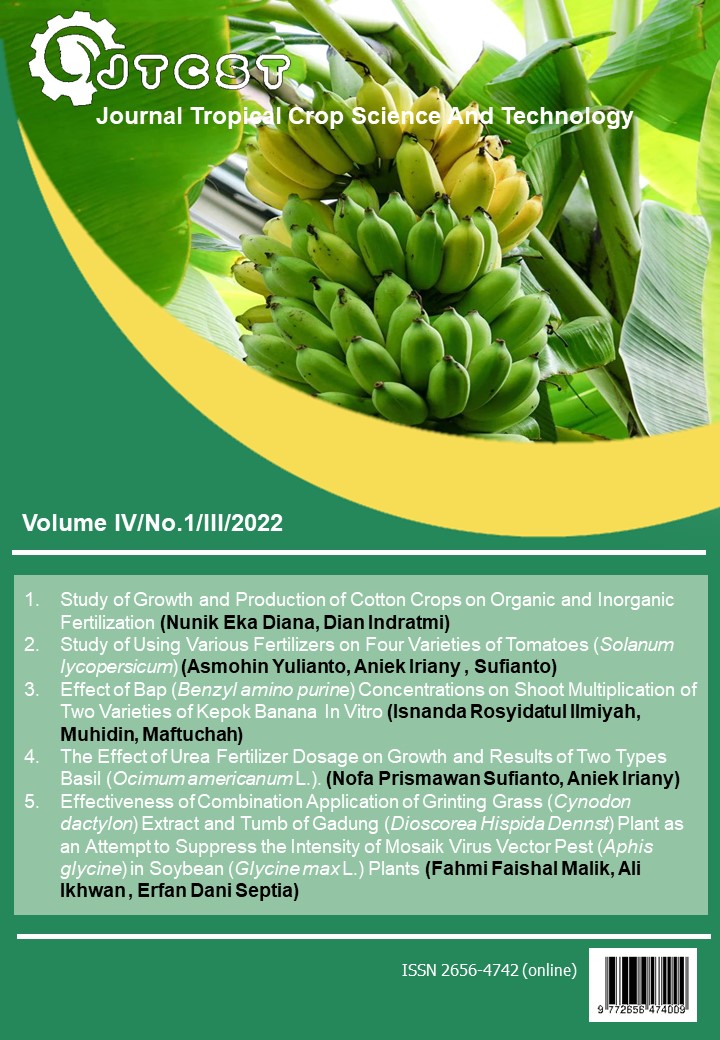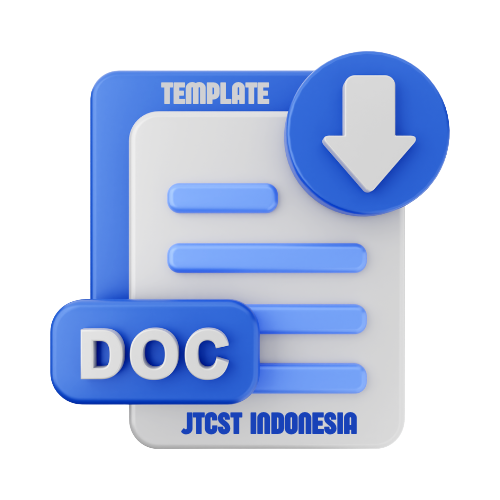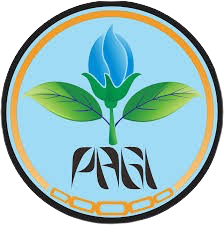The Effect of Urea Fertilizer Dosage on Growth and Results of Two Types Basil (Ocimum americanum L.).
DOI:
https://doi.org/10.22219/jtcst.v4i1.29756Keywords:
Ocimum americanum L, Dosage, nitrogen fertilizerAbstract
Basil can be grown in all regions of Indonesia. The purpose of this study was to identify the response of 2 types of basil against the use of N fertilizer dose on the early growth. In the growth process, plants require sufficient nutrients so that the physiological processes in plants’ organs can be held properly. The nutrients used by plants can be sourced from within the soil itself or in the form of fertilizers that have been put into the soil. Plants will grow properly if the elements needed by plants are fulfilled. The research was carried out from February to April 2022 at the Experimental Field of the Faculty of Agriculture and Animal Husbandry at the University of Muhammadiyah Malang. The design used in this study was the factorial Randomized Complete Block Design (RCBD) with a treatment dose of Urea fertilizer in basil type. The results showed that there was no interaction between the types of basil and the dose of urea at all the observation parameters. On the other side, the type of basil affects the parameters of the number of leaves, plant height, and total fresh weight where the type of tidore basil was better than other types of basil. Furthermore, the urea fertilizer dose treatment affected the number of leaves, plant height, and total fresh weight where the better urea fertilizer dose was N125.
Downloads
References
Azmi, F. 2016 Penentuan Dosis Optimum Pupuk Nitrogen Pada Kemangi (Ocimum basilicum L.) di Tanah Inceptisol. Skripsi. IPB. Bogor.
Abdul SW. 2003. Peningkatan efisiensi pupuk nitrogen pada padi sawah dengan metode bagan warna daun. Jurnal Litbang Pertanian. 22(4): 156-161
Departemen Pertanian. 2012. Potensi Kemangi (Ocimum americanum L.) Sebagai Pestisida Alami. http://www.diperta.jabarprov.go.id/. Diakses pada 8 April 2018.
Delyani, R. dan J. G. Kartika. 2016. Pengaruh Pupuk Nitrogen dan Pupuk Hayati Cair Terhadap Pertumbuhan dan Produksi Sayuran Daun Indigenous Tahunan. Bul. Agrohorti. 4(3): 335-342
Engle, L.M., Altoveros, N.C. 2000. Collection, Conservation and Utilization of Indigenous Vegetables. Shanhua: AVRDC
Endrizal B, Julistia. 2004. Efisiensi penggunaan pupuk nitrogen dengan penggunaan pupuk organik pada tanaman padi sawah. J PPTP. 7(2):118-124.
Filaprasetyowati, N. E., M. Santosa dan N. Herlina. 2015. Kajian Penggunaan Pupuk Biourine Sapi dan Pupuk Anorganik Terhadap Pertumbuhan dan Hasil Tanaman Bawang Daun (Allium fistulosum L.). J. Produksi Tanaman. 3(3): 239-248.
Nazaruddin. 1995. Budidaya dan Pengaturan Panen Sayuran Dataran Rendah. Jakarta (ID): Penebar Swadaya.
Gardner FP, Pearce RB, Mitchell RL. 1991. Fisiologi Tanaman Budidaya. (Terjemahan oleh Herawati Susilo). Jakarta: UI Press.
Gigir, S. F., J. J. Rondonuwu, W. J. N. Kumolontang dan R. I. Kawulusan. 2014. Respons Pertumbuhan Kemangi (Ocimum sanctum L.) Terhadap Pemberian Pupuk Organik dan Anorganik. Lecturer of Soil Science Department of Agriculture Faculty, Sam Ratulangi University.
Hadipoentyanti, E, dan S. Wahyuni. 2006. Keragaman Selasih (Ocimum spp.) Berdasarkan Karakter Morfologi Produksi dan Mutu Herba. Jurnal Littri.14(4): 141–148
[Kementan] Kementrian Pertanian. 2010. Konsumsi sayur masyarakat Indonesia di bawah rekomendasi FAO [internet]. [diunduh 13 Januari 2022]. www.agro.agroprima. com.
Lingga P. Marsono. 2008. Petunjuk Penggunaan Pupuk. Jakarta: Penebar Swadaya
Siemonsma, J. S. 2008. PROSEA: Plant Resource of Southeast Asia vol 8: Vegetables. Piluek K, editor. PUDOC. Wageningen.
Rakhmiati Y, Fahrurrozi. 2003. Respon tanaman sawi terhadap proporsi dan takaran pemberian N. Jurnal Wacana Pertanian (3): 119- 121.
Setiawan, W. O, L, Tobing dan A, Rahayu. 2018. Pertumbuhan Dan Produksi Aksesi Kemangi (Ocimum Basilicum L.) Pada Berbagai Komposisi Pupuk Kcl Dan Urine Sapi. Fakultas Pertanian, Universitas Djuanda Bogor
Sitompul, S.M. dan B. Guritno. 1995. Analisis pertumbuhan tanaman. UGM Press. Yogyakarta.
Sastro, Y.dan I. P. Lestari. Kementan BPTP. 2012. Teknis Budidaya Sayuran Daun Mendukung Terciptanya Kawasan Rumah Pangan Lestari (KRPL) Di Perkotaan. Jl. Raya Ragunan No. 30 Pasar Minggu, Jakarta Selatan. Jakarta. p. 15-18.
Silalahi M. 2014. The Ethnomedicine of The Medicinal Plants in Sub-ethnic BatakNorth Sumatra and The Conservation Perspective. [Disertation]. Program Studi Biologi, Program Pasca Sarjana, FMIPA, Universitas Indonesia. [unpublished]. Silalahi M. 2014. The Ethnomedicine of The Medicinal Plants in Sub-ethnic BatakNorth Sumatra and The Conservation Perspective. [Disertation]. Program Studi Biologi, Program Pasca Sarjana, FMIPA, Universitas Indonesia. [unpublished].
Yunus, A., Hadiwiyono, Samanhudi dan A. T. Sakya. 2016. Proceedings The 2nd International Rainforest Conference Climate Change Mitigation Through Sustainable Rainforest Farming and Community-Based Livelihood. Universitas Sebelas Maret. Surakarta. p. 57-58.
Zahra, S. dan Y. Iskandar. 2014. Kandungan Senyawa Kimia dan Bioaktivitas Kemangi (Ocimum basilicum L.). Unpad. J. Farmaka. 15(3): 143-15.
Downloads
Published
How to Cite
Issue
Section
License
Copyright (c) 2022 Nofa Prismawan, Aniek Iriany, sufianto

This work is licensed under a Creative Commons Attribution-ShareAlike 4.0 International License.
Authors who publish with this journal agree to the following terms:
- Authors retain copyright and grant the journal right of first publication with the work simultaneously licensed under a Creative Commons Attribution License that allows others to share the work with an acknowledgement of the work's authorship and initial publication in this journal.
- Authors are able to enter into separate, additional contractual arrangements for the non-exclusive distribution of the journal's published version of the work (e.g., post it to an institutional repository or publish it in a book), with an acknowledgement of its initial publication in this journal.
- Authors are permitted and encouraged to post their work online (e.g., in institutional repositories or on their website) prior to and during the submission process, as it can lead to productive exchanges, as well as earlier and greater citation of published work (See The Effect of Open Access).











